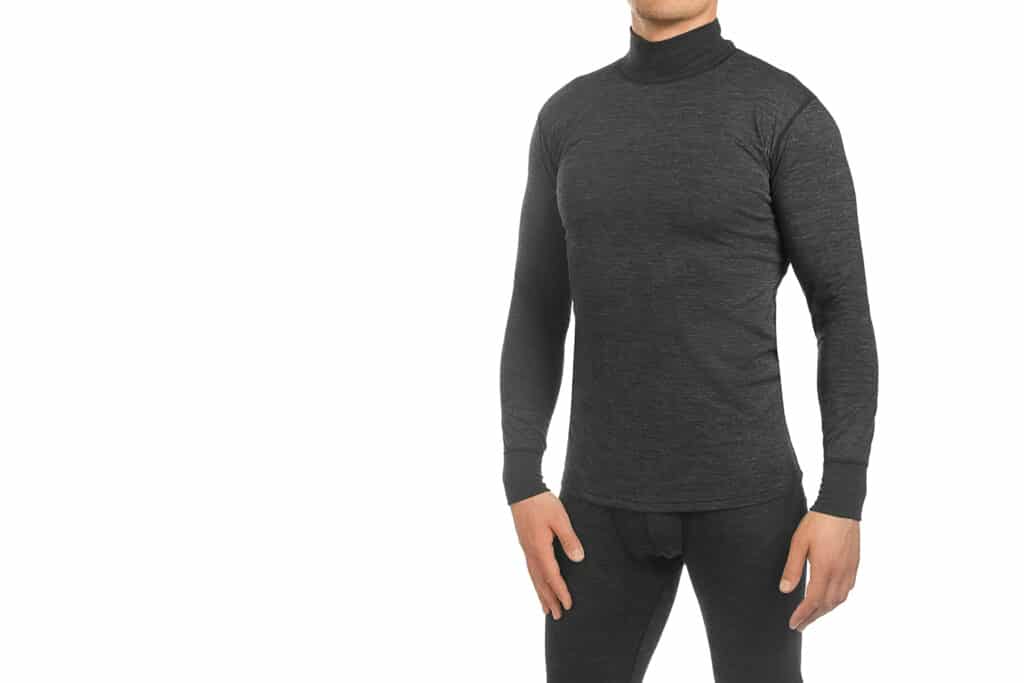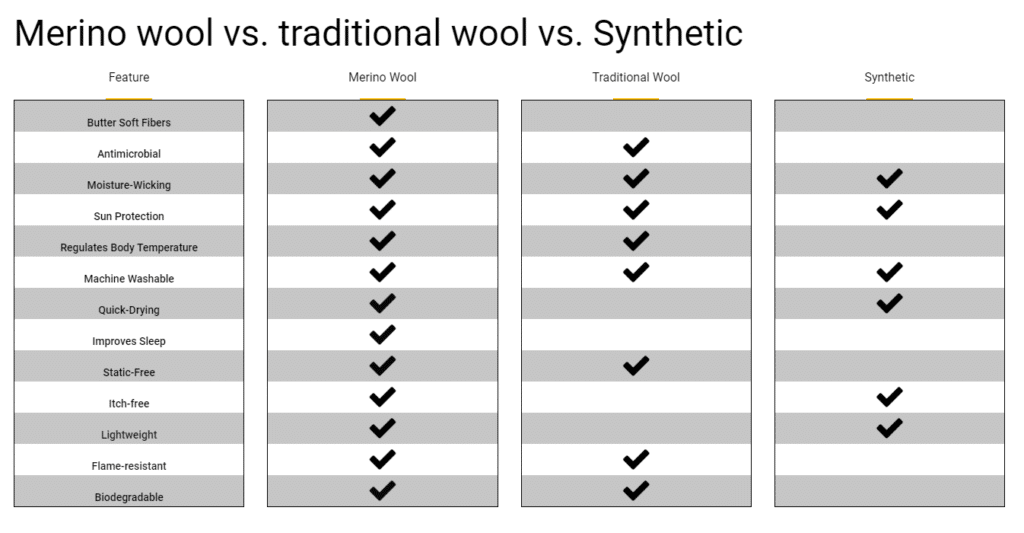The Ultimate Base Layer Face-Off: Merino Vs. Synthetic

Our content may include affiliate links, through which we earn a small commission on purchases. Want to learn more about us? Read here.
There are a lot of different materials and fabrics that can be used for base layers these days, so it can be tricky to choose the right one for your needs. In this blog post, we’ll compare two of the most popular options: synthetic base layer and merino wool base layer.
We’ll review each material’s pros and cons so you can decide which is right for you.
What is a Base Layer?
A base layer is clothing often worn underneath other items to regulate body temperature. It is not just for cold weather: it helps keep you cool during hot periods. Base layers are typically made from synthetic or merino, and both offer exceptional breathability and moisture-wicking qualities to quickly move liquid away from your skin.
This keeps sweat and other moisture off your skin and allows the material to dry faster, ultimately helping you stay comfortable when temperatures change or fluctuate.
The Benefits of Synthetics as Base Layers
Synthetic base layers are popular among outdoor adventurers as they provide cooling and warmth when needed. Their lightweight properties make them ideal for use as base layers, as they provide moisture-wicking capabilities that reduce the chances of developing uncomfortable rashes or blisters.

This is particularly important during strenuous activities with higher sweat and cooling needs than usual. Synthetic base layers have become essential for those seeking to stay cool or warm and comfortable in any temperature or environment.
Merino Wool and its Benefits as a Base Layer Fabric
Merino base layers are renowned for being a premier fabric for base layers due to their natural warmth, cooling abilities, and moisture-wicking properties. Merino wool base layer is the optimal choice for cold weather expeditions because of its insulating layers that keep you comfortable no matter the conditions.

With its ability to rapidly absorb and evaporate sweat, a merino base also regulates body temps – providing warmth in colder climates and cooling in warmer ones. Additionally, merino wool’s lightweight construction makes it ideal for all activities: heading out on an adventure or running errands around town.
Merino base layer is an excellent choice for base layers giving you warmth and comfort no matter where your everyday adventures take you.
Synthetic Base Layers vs. Merino Wool Base Layers in Terms of Warmth, Breathability, Durability, and Price
Depending on your needs, a synthetic base layer and a merino base layer can be great options for keeping warm when outdoor activities are in the future.
The newest synthetic base layers excel at quickly drying out from any moisture buildup, whereas merino wool base layers are known for their superior ability to keep the wearer warm even when wet, plus wick moisture away from the body.
Merino wool also provides exceptional breathability and comfort, making it a solid choice for colder temperatures. Durability-wise, synthetic base layers will generally prove more resilient than natural fibers such as merino wool in terms of overall lifespan.
Finally, synthetic fibers can often offer a lower cost depending on the type selected while still providing good functionality compared with merino wool.
Warmth
It’s essential to choose the suitable fabric for cold weather, as that can be the difference between feeling warm and comfortable versus cold and uncomfortable. Synthetic fibers such as nylon, polyester, and acrylic are lightweight options often used in athletic clothing.
However, the Merino wool base layer is the best option for keeping warm in chilly temperatures. Merino wool insulates body heat while also releasing sweat, which helps you stay dry and warm. Furthermore, merino wool is well-known for being incredibly soft and lightweight, making it an excellent choice for clothing that keeps us warm.
Ultimately, if you want your winter wardrobe items to stand up against cold temperatures while still being comfortable, then merino wool is your best choice.
Winner – Merino
Breathability
Materials like synthetic fibers and merino wool are both popular choices for clothing, but when it comes to breathability, which one performs better? In reality, it may depend on the thickness of the fabric used in either case.
Generally speaking, merino wool will offer more breathability than synthetic fabric when those two fabrics are made from a similar thread thickness. Merino wool has microscopic “air pockets” that provide extra airflow while also wicked away sweat and moisture.
Winner – Merino
Durability
Synthetic fibers like polyester have excellent properties that last longer than natural fibers like wool. Depending on the application, either fabric could be an excellent choice for clothing; however, synthetic fibres tend to be better at resisting wear and tear.
Winner – Synthetic
Price
Compared to synthetic fabrics, merino wool is more expensive. But unlike many types of man-made fabrics, Merino wool is biodegradable, creating less landfill waste over time and thus reducing our carbon footprint in the long term.
Ultimately, while there may be an upfront cost associated with using merino wool instead of synthetic fabrics, the benefits that come with it can make this choice a worthwhile investment.
Winner – Merino
Recommendations for When to Choose Each Type of Fabric
When looking for the perfect base layer for any activity, wool and synthetic fibres have their strengths and weaknesses. If sustainability is your top priority, wool is the fabric of choice. Merino fibres have superior breathability and water resistance and are a natural fiber from one of the most sustainable sources available- Merino sheep!
On the flip side, while synthetic fabrics are made with man-made materials and often contain plastics, they have better heat retention and dry faster than wool. Choosing between wool or synthetic depends on which features matter most to you.

Patagonia Capilene Midweight Crew ($79)
The Patagonia Capilene Midweight Crew is the perfect choice for anyone looking for superior warmth and exceptional breathability. This lightweight mid-layer is designed with Polartec Power Grid fabric to provide long-lasting performance and minimize bulk.
Its airy construction creates a second skin that allows body heat to escape, helping regulate your temperature without adding extra weight. The fabric also features Polygiene permanent odor control, which helps keep you smelling fresh on extended outdoor adventures.
The Capilene Midweight Crew has an offset shoulder seam, underarm gussets, a low-bulk waistband, and an unobtrusive drop tail for maximum comfort and convenience. Whether you’re hitting the trails or exploring in chilly temperatures, this comfortable layer will help you stay warm and dry all day!
Helly Hansen Lifa Stripe Crew ($60)
If you’re looking for a top that can keep up with any outdoor activity, the Helly Hansen Lifa Stripe Crew is just the one for you. It’s composed of an insulation layer from the renowned Lifa® technology fabric, keeping you warm even on those coldest days.
The fabric also has wicking properties so your body can breathe and stay dry no matter how intense your workouts get. On top of that, this lightweight top won’t feel too heavy as you run or ski, making it perfect for any winter sport.
With its original striped design and contemporary fit, this stylish addition to your wardrobe will always have you looking good while performing at your best.
Ridge Merino Aspect Midweight Quarter Zip ($80)
If you’re looking for the most comfortable, high-performance midweight layer for your outdoor adventure, look no further than the Ridge Merino Aspect Midweight Quarter Zip. This soft and lightweight wool blend design is made from 87% Merino wool and 13% polyester, providing warmth and breathability while you stay active in cooler temperatures.
Its four-way stretch construction gives it an exceptional range of motion so that no matter the activity – running, hiking, skiing, or cycling – this layer will keep up with your pace. Its durable flatlock seams reduce bulkiness and chaffing for a comfortable all-day fit. There’s no better way to take on your next outdoor challenge than with the Ridge Merino Aspect Midweight Quarter Zip.
Woolx Glacier Long Sleeve Crew ($150)
Keep your style cool with the Woolx Glacier Long Sleeve Crew. This comfortable garment is made from ultra-soft Merino wool, offering a unique warmth and breathability. The perfect addition to any outdoor wardrobe, the crew will keep you warm even when temperatures drop.
Natural fabric properties help regulate your body temperature while repelling moisture, ensuring a dry and comfortable experience no matter the weather. With its sleek look and modern design, this long sleeve crew adds a touch of sophistication to any outfit – a must-have for any outdoor lover!
Pros and Cons
When selecting a base layer for active endeavors, evaluating the pros and cons of synthetic and merino wool options is essential.
Synthetic materials can offer superior durability, making them a good choice if you use your base layer multiple times in rough conditions. They are also typically lightweight and dry quickly due to the added properties of moisture-wicking fabrics.
Synthetic fibers have become increasingly popular in the textile industry due to their durability and affordability. Polyester is one of the leading synthetic fibers used today, and it is made using petroleum-based products such as coal, air, and water.
These materials are combined and heated to create polyester until they form into large plastic sheets. From there, the plastic is drawn into tiny filaments that can be woven to create fibers for clothing and other textiles.
Synthetic fibers like polyester provide a great alternative to natural fibers like cotton or wool due to their strength, lightweight feel, and wrinkle resistance.
On the other hand, merino wool offers superior breathability, temperature regulation, and odor resistance due to its natural characteristics. However, one downside of using merino wool for garments is that it is more prone to wear and tear than synthetic.
While merino may initially be more expensive than synthetics, replacing the garment more frequently may cost more over time. If you choose to go with merino wool clothing, opt for items made from thicker fabrics, as they are typically more durable.
Additionally, while wearing your garment, often air it out in between use and wash it according to the instructions on the tag – this will help increase its longevity.
Merino wool has become increasingly popular in recent years due to its breathability and ability to regulate body temperature. While merino wool offers various benefits, some downsides are associated.
One concern is that this type of fabric can be pricey and may not fit within everyone’s budget. In addition, it is not as practical for garments as synthetic materials such as nylon and polyester, as merino wool runs the risk of stretching out when wet and can pill over time.
Finally, while merino wool naturally resists odors, regular laundering is necessary to keep it smelling fresh and extend its lifespan.
Conclusion
Although synthetic and merino base layers have advantages, choosing the suitable fabric for your needs is essential. For a warm, durable, and affordable base layer, synthetic fabric is a great option.
However, merino wool is the way to go if you need a breathable and odor-resistant base layer. Ultimately, the best fabric for you will depend on your individual needs and preferences.






